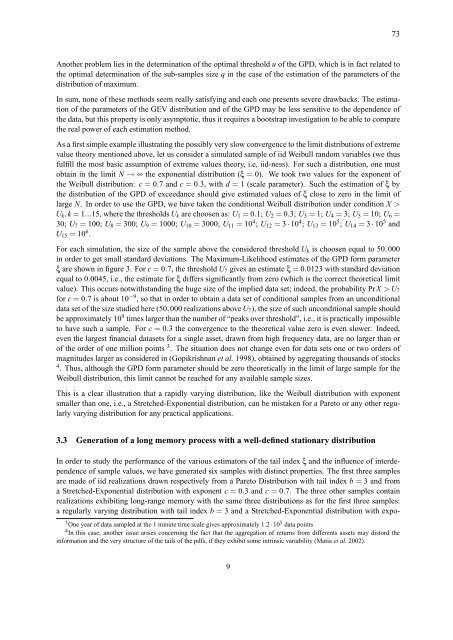statistique, théorie et gestion de portefeuille - Docs at ISFA
statistique, théorie et gestion de portefeuille - Docs at ISFA
statistique, théorie et gestion de portefeuille - Docs at ISFA
Create successful ePaper yourself
Turn your PDF publications into a flip-book with our unique Google optimized e-Paper software.
Another problem lies in the d<strong>et</strong>ermin<strong>at</strong>ion of the optimal threshold u of the GPD, which is in fact rel<strong>at</strong>ed to<br />
the optimal d<strong>et</strong>ermin<strong>at</strong>ion of the sub-samples size q in the case of the estim<strong>at</strong>ion of the param<strong>et</strong>ers of the<br />
distribution of maximum.<br />
In sum, none of these m<strong>et</strong>hods seem really s<strong>at</strong>isfying and each one presents severe drawbacks. The estim<strong>at</strong>ion<br />
of the param<strong>et</strong>ers of the GEV distribution and of the GPD may be less sensitive to the <strong>de</strong>pen<strong>de</strong>nce of<br />
the d<strong>at</strong>a, but this property is only asymptotic, thus it requires a bootstrap investig<strong>at</strong>ion to be able to compare<br />
the real power of each estim<strong>at</strong>ion m<strong>et</strong>hod.<br />
As a first simple example illustr<strong>at</strong>ing the possibly very slow convergence to the limit distributions of extreme<br />
value theory mentioned above, l<strong>et</strong> us consi<strong>de</strong>r a simul<strong>at</strong>ed sample of iid Weibull random variables (we thus<br />
fulfill the most basic assumption of extreme values theory, i.e, iid-ness). For such a distribution, one must<br />
obtain in the limit N → ∞ the exponential distribution (ξ = 0). We took two values for the exponent of<br />
the Weibull distribution: c = 0.7 and c = 0.3, with d = 1 (scale param<strong>et</strong>er). Such the estim<strong>at</strong>ion of ξ by<br />
the distribution of the GPD of exceedance should give estim<strong>at</strong>ed values of ξ close to zero in the limit of<br />
large N. In or<strong>de</strong>r to use the GPD, we have taken the conditional Weibull distribution un<strong>de</strong>r condition X ><br />
Uk,k = 1...15, where the thresholds Uk are choosen as: U1 = 0.1; U2 = 0.3; U3 = 1; U4 = 3; U5 = 10; U6 =<br />
30; U7 = 100; U8 = 300; U9 = 1000; U10 = 3000; U11 = 10 4 ; U12 = 3 · 10 4 ; U13 = 10 5 ; U14 = 3 · 10 5 and<br />
U15 = 10 6 .<br />
For each simul<strong>at</strong>ion, the size of the sample above the consi<strong>de</strong>red threshold Uk is choosen equal to 50,000<br />
in or<strong>de</strong>r to g<strong>et</strong> small standard <strong>de</strong>vi<strong>at</strong>ions. The Maximum-Likelihood estim<strong>at</strong>es of the GPD form param<strong>et</strong>er<br />
ξ are shown in figure 3. For c = 0.7, the threshold U7 gives an estim<strong>at</strong>e ξ = 0.0123 with standard <strong>de</strong>vi<strong>at</strong>ion<br />
equal to 0.0045, i.e., the estim<strong>at</strong>e for ξ differs significantly from zero (which is the correct theor<strong>et</strong>ical limit<br />
value). This occurs notwithstanding the huge size of the implied d<strong>at</strong>a s<strong>et</strong>; in<strong>de</strong>ed, the probability PrX > U7<br />
for c = 0.7 is about 10 −9 , so th<strong>at</strong> in or<strong>de</strong>r to obtain a d<strong>at</strong>a s<strong>et</strong> of conditional samples from an unconditional<br />
d<strong>at</strong>a s<strong>et</strong> of the size studied here (50,000 realiz<strong>at</strong>ions above U7), the size of such unconditional sample should<br />
be approxim<strong>at</strong>ely 10 9 times larger than the number of “peaks over threshold”, i.e., it is practically impossible<br />
to have such a sample. For c = 0.3 the convergence to the theor<strong>et</strong>ical value zero is even slower. In<strong>de</strong>ed,<br />
even the largest financial d<strong>at</strong>as<strong>et</strong>s for a single ass<strong>et</strong>, drawn from high frequency d<strong>at</strong>a, are no larger than or<br />
of the or<strong>de</strong>r of one million points 3 . The situ<strong>at</strong>ion does not change even for d<strong>at</strong>a s<strong>et</strong>s one or two or<strong>de</strong>rs of<br />
magnitu<strong>de</strong>s larger as consi<strong>de</strong>red in (Gopikrishnan <strong>et</strong> al. 1998), obtained by aggreg<strong>at</strong>ing thousands of stocks<br />
4 . Thus, although the GPD form param<strong>et</strong>er should be zero theor<strong>et</strong>ically in the limit of large sample for the<br />
Weibull distribution, this limit cannot be reached for any available sample sizes.<br />
This is a clear illustr<strong>at</strong>ion th<strong>at</strong> a rapidly varying distribution, like the Weibull distribution with exponent<br />
smaller than one, i.e., a Str<strong>et</strong>ched-Exponential distribution, can be mistaken for a Par<strong>et</strong>o or any other regularly<br />
varying distribution for any practical applic<strong>at</strong>ions.<br />
3.3 Gener<strong>at</strong>ion of a long memory process with a well-<strong>de</strong>fined st<strong>at</strong>ionary distribution<br />
In or<strong>de</strong>r to study the performance of the various estim<strong>at</strong>ors of the tail in<strong>de</strong>x ξ and the influence of inter<strong>de</strong>pen<strong>de</strong>nce<br />
of sample values, we have gener<strong>at</strong>ed six samples with distinct properties. The first three samples<br />
are ma<strong>de</strong> of iid realiz<strong>at</strong>ions drawn respectively from a Par<strong>et</strong>o Distribution with tail in<strong>de</strong>x b = 3 and from<br />
a Str<strong>et</strong>ched-Exponential distribution with exponent c = 0.3 and c = 0.7. The three other samples contain<br />
realiz<strong>at</strong>ions exhibiting long-range memory with the same three distributions as for the first three samples:<br />
a regularly varying distribution with tail in<strong>de</strong>x b = 3 and a Str<strong>et</strong>ched-Exponential distribution with expo-<br />
3 One year of d<strong>at</strong>a sampled <strong>at</strong> the 1 minute time scale gives approxim<strong>at</strong>ely 1.2 · 10 5 d<strong>at</strong>a points<br />
4 In this case, another issue arises concerning the fact th<strong>at</strong> the aggreg<strong>at</strong>ion of r<strong>et</strong>urns from differents ass<strong>et</strong>s may distord the<br />
inform<strong>at</strong>ion and the very structure of the tails of the pdfs, if they exhibit some intrinsic variability (M<strong>at</strong>ia <strong>et</strong> al. 2002).<br />
9<br />
73




